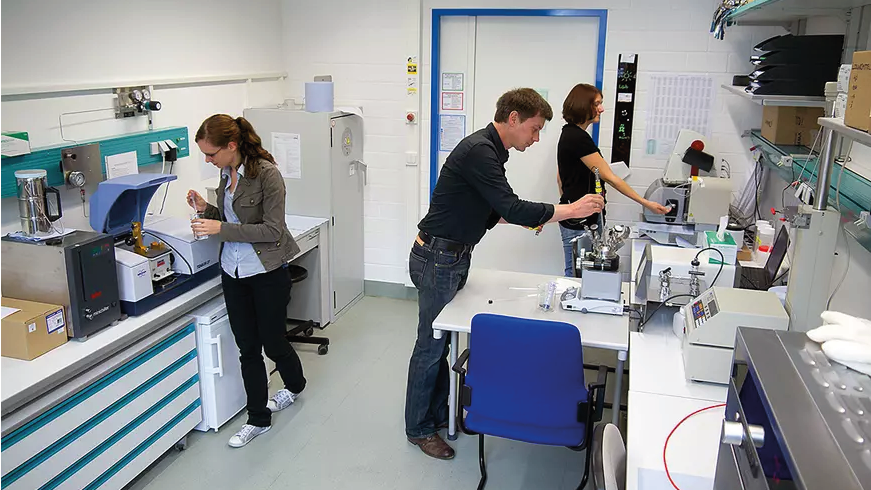Labor Fluidphysik
Kontakt:
Web:
Infrastrukturzugehörigkeit:
Im Labor für Fluidphysik werden verschiedene Geräte eingesetzt, um die Eigenschaften von geothermischen Fluiden zu bestimmen: Dichte, Viskosität, elektrische Leitfähigkeit, Wärmeleitfähigkeit, Wärmekapazität, Schallgeschwindigkeit.
Ausgewählte Infrastrukturen
Fachspezifische Schlagworte
- Differential Scanning Calorimetry
- Petrophysics
- Fourier Transform Infrared Spectroscopy
- Density Measurement
- Viscosimetry
- Electrical Conductivity Measurement
- Sonic Velocity
- Thermal Conductivity Measurement
- Thermophysical Properties
- Geochemie
Kategorien
Instrumentierung
Laboratory instrumentation
Instrumente
-
Density Meter
-
Thermal Conductivity Analyzer
-
Viscosimeter
-
Ultrasonic Transducer
-
Differential Scanning Calorimeter
Technique where the difference between heat flow rates into a sample and a reference material is measured (heat-flow DSC). Technique where the difference between the electrical powers into a sample and a reference material is measured (power compensation DSC). (Source: IUPAC; https://doi.org/10.1515/pac-2012-0609)
-
Conductivity Sensor
Sensors that measure the electrical conductance per unit distance in an electrolytic or aqueous solution. (Source: Global Change Master Directory (GCMD). 2023. GCMD Keywords, Version 16.3. Greenbelt, MD: Earth Science Data and Information System, Earth Science Projects pision, Goddard Space Flight Center (GSFC) National Aeronautics and Space Administration (NASA). URL (GCMD Keyword Forum Page): https://forum.earthdata.nasa.gov/app.php/tag/GCMD+Keywords)
-
Fourier Transform Infrared Spectrometer
FTIR Spectrometer - Fourier Transform Infrared Spectrometer Traditional (dispersive) infrared techniques experience difficulties due to the '1 wavenumber at a time' nature of data acquisition. This leads to either a poor signal to noise ratio in a spectrum or a very long time needed to obtain a high quality spectrum. Both these situations cause problems with kinetic work. The first gives inherent large errors, the second prohibits in-situ work. These problems can be overcome using Fourier transform infrared spectroscopy (FT-IR) that is based on the interferometer originally designed by Michelson and a mathematical procedure developed by Fourier that converts response from the 'time' to the 'frequency' domain.
In the Michelson interferometer a parallel, polychromatic beam of radiation from a source (A) is directed to a beam splitter (B), made from an infrared transparent material, such as KBr. The beam splitter reflects approximately half of the light to a mirror, known as the fixed mirror (C), which in turn reflects the light back to the beam splitter. The rest of the light passes through to a mirror, moving continuously, at a known velocity, back and forth along the direction of the incoming light and this is known as the moving mirror (D). Upon reflection from the moving mirror, radiation is then directed back to the beam splitter. At the beam splitter some of the light that has been reflected from the fixed mirror combines with light reflected from the moving mirror and is directed towards the sample. After passing through the sample (E) the radiation is focused onto the detector (F). The detectors are sufficiently fast to cope with time domain signal changes from the modulatio n in the interferometer. Additional information available at http://physics.nist.gov/Divisions/Div842/Gp1/fts_intro.html (Source: Global Change Master Directory (GCMD). 2023. GCMD Keywords, Version 16.3. Greenbelt, MD: Earth Science Data and Information System, Earth Science Projects pision, Goddard Space Flight Center (GSFC) National Aeronautics and Space Administration (NASA). URL (GCMD Keyword Forum Page): https://forum.earthdata.nasa.gov/app.php/tag/GCMD+Keywords)
